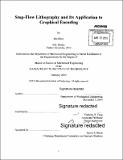Stop-flow lithography and its application to graphical encoding
Author(s)
Chen, Mo, Ph. D. Massachusetts Institute of Technology
DownloadFull printable version (16.17Mb)
Other Contributors
Massachusetts Institute of Technology. Department of Mechanical Engineering.
Advisor
Nicholas X. Fang.
Terms of use
Metadata
Show full item recordAbstract
Colloids of a few to tens of microns have shown great promise in various applications. For practical purposes, colloidal building blocks which self-assemble into operational device are sometimes desired. This preprogrammed assembly requires large quantities of colloidal building blocks with well-defined shape, size and composition, which cannot be provided with existing techniques. In this thesis, a new fabrication technique is presented combining Stop-Flow Lithography (SFL) and a spatial light modulator (SLM). With this technique, geometrically anisotropic colloid particles are generated at high throughput (~106 particles/h). Fabrication of functional materials such as hydrogel and shape memory polymer is proven compatible. All candidate materials can be combined to form chemically anisotropic colloid particles like Janus particles. Further, the feedback mechanism of our system allows adaptive fabrication according to detected suspensions. On the one hand, this extends our material selection pool for the building blocks, as materials incompatible with direct SFL fabrication are incorporated by encapsulation; on the other hand, this capability applies to single cell encapsulation and graphical encoding. This powerful tool facilitates fabrication of complex building blocks and potentially promotes self-assembly and application of colloids. Another project covered in this thesis is called solid-state superionic stamping (S4). It is a direct patterning technique for metals, featuring one-step, large fabrication area, low cost and working in ambient conditions. This technique is complementary to SFL in the sense that it enlarges material selection pool.
Description
Thesis: S.M., Massachusetts Institute of Technology, Department of Mechanical Engineering, 2015. Cataloged from PDF version of thesis. Includes bibliographical references (pages 72-77).
Date issued
2015Department
Massachusetts Institute of Technology. Department of Mechanical EngineeringPublisher
Massachusetts Institute of Technology
Keywords
Mechanical Engineering.